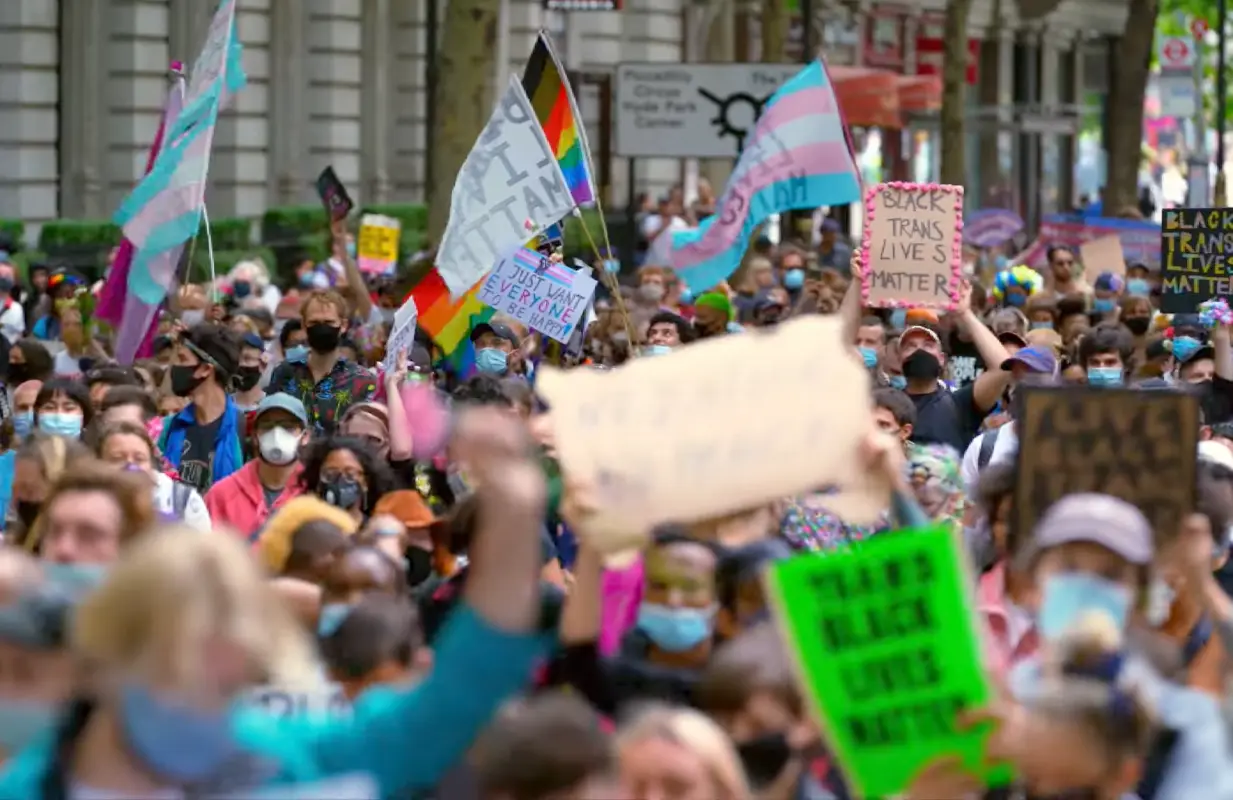FX's Pride Is Both a Celebration and an Urgent Call to Action
-
 Black Trans Lives Matter demonstrators gathered by the thousands last June in London. (Photo: FX)
Black Trans Lives Matter demonstrators gathered by the thousands last June in London. (Photo: FX)One of the sad truths about marginalized communities in this country is that our histories are so rarely told. Some of the best television shows of the last few years, like Watchmen and Pose, have attempted to take the steps that our educational system hasn't by telling the stories of Black or queer communities through the years. FX's Pride, a six-episode documentary series premiering this week, takes a unique approach as it seeks to shine a spotlight on some of the lesser known events and figures in LGBTQ+ history, enlisting six renowned queer directors to each helm their own episode.
Pride comes at a pivotal time for the queer rights movement, something that the show seems well aware of. While each episode in the series feels like the distinct creation of its filmmaker, each with its own documentary approach — some use reenactments while others make use of archival footage — the consistent throughline is a recontextualization of gay history as a constantly moving and decidedly activist fight for civil rights. The past year, one which has encompassed not only a pandemic and a presidential election but also a national racial reckoning, has called for a reexamination of gay pride and what it means to be an inclusive queer community. The historical centering of white, cisgender gay men in queer media and messaging is giving way to LGBTQ+ activism centering transgender people and queer people of color, two communities most threatened by the current climate. In addition to spotlighting untold stories of queer people in history, Pride actively critiques the ways in which the queer rights movement recognizes, makes space for, and has historically failed transgender people and queers of color. As queer activist Susan Stryker puts it at the end of the first episode, "Let's hold off on Pride until we've actually achieved justice."
Each episode of Pride centers on a different decade in the fight for gay civil rights. Within that decade, the episode spotlights a few people or events that have gone under-discussed. In this way, it's quite similar to the HBO Max docuseries Equal from last fall, and in fact some of the stories — like 1950s transgender celebrity Christine Jorgensen and organizer of the March on Washington Bayard Rustin — appear in both series. Pride exhibits a tighter focus than its predecessor, though, even as the directorial approaches change from episode to episode. Episode 1, on the 1950s, is helmed by New Queer Cinema pioneer Tom Kalin (director of Swoon) and depicts the 'Lavender Scare," the McCarthy witch hunts that targeted gay people in government (and their family members) for harrassment and blackmail, including the horrifying story of Wyoming senator Lester Hunt, whose son was entrapped for solicitation for the purposes of blackmail.
Often the episodes will nod to more widely known queer history before taking a left turn into more obscure subjects. Director Andrew Ahn's episode on the 1960s opens on Stonewall before delving deeper into the story of drag queen Flawless Sabrina and how the drag scene of the 1960s was a form of protest against the respectability politics of the homophile organizations of that time, which shunned the more flamboyant elements of the community as unsavory. Again, Pride takes something as mainstream in 2021 as drag (evidenced by VH1's year-round Drag Race programming strategy) and connects it to its history of queer protest and activism. Cheryl Dunye's episode on the 1970s spotlights lesbian artists Barbara Hammer and Audre Lord as an entry point to talking about how the women's movement tried to exclude lesbians — that "lavender menace," as Betty Freidan called them — despite the fact that, as activist Cheryl Clarke puts it, "feminism is lucky to have lesbians, or else no radical work would be getting done."
Again and again, Pride centers activism in the queer experience, citing multiple examples of how queer groups like the Gay Liberation Front took their cues from the Black Power movements of the '60s and '70s in seeking to organize and agitate for their own rights. As the series continues with episodes directed by Anthony Carona and Alex Smith, Yance Ford, and Ro Haber, these civil rights movements from decades past become inextricably linked to the activist movements of the present day, with figures like trans activist Ceyenne Doroshow and Act Up pioneer Ann Northrop fighting to transform the notion of Pride from a corporate-sponsored party to an active and ongoing fight for the rights of all LGBTQ+ people, especially our Black, brown, and trans siblings.
Pride is both a celebration and a call to action, which feels like the right match for the queer experience in 2021. The show feels as close as anything I've experienced to a complete and wide-ranging living queer history, touching on everything from witch hunts to Stonewall to drag to Harvey Milk to the AIDS crisis to the Defense of Marriage Act to last summer's protests in the streets. Pride tells us we're living this history now, and that celebrating these under-examined lives and struggles and battles is a powerful way to equip ourselves to keep the fight going
The first three episodes of Pride air back-to-back on FX Friday May 14 at 8:00 PM ET, with the final three premiering the same time a week later on Friday May 21. Episodes stream the next day on Hulu.
Joe Reid is the senior writer at Primetimer and co-host of the This Had Oscar Buzz podcast. His work has appeared in Decider, NPR, HuffPost, The Atlantic, Slate, Polygon, Vanity Fair, Vulture, The A.V. Club and more.
TOPICS: Pride (FX series), FX, LGBTQ